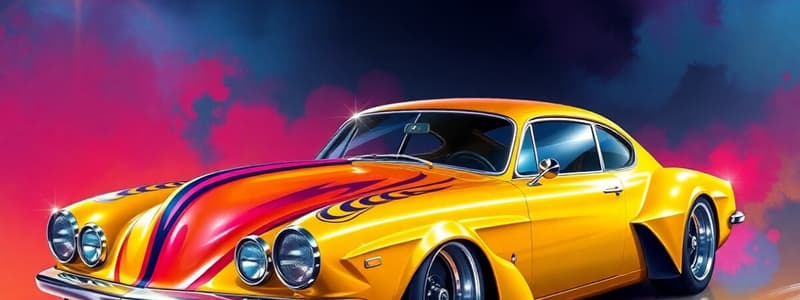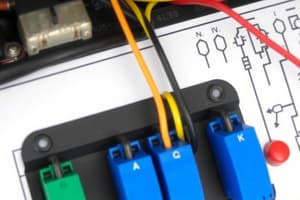Podcast
Questions and Answers
Where can you typically find paint codes on a vehicle?
Where can you typically find paint codes on a vehicle?
Quantitative Mixing involves using a progressive weight addition method.
Quantitative Mixing involves using a progressive weight addition method.
What are the three primary colors that serve as the foundation for all other colors?
What are the three primary colors that serve as the foundation for all other colors?
The standard basecoat-to-reducer ratio is often ______.
The standard basecoat-to-reducer ratio is often ______.
What does 'hue' represent in color theory?
What does 'hue' represent in color theory?
Match the following terms to their definitions:
Match the following terms to their definitions:
What is the significance of understanding 'flop' in automotive refinishing?
What is the significance of understanding 'flop' in automotive refinishing?
Which light source provides the most accurate representation of color for automotive refinishing?
Which light source provides the most accurate representation of color for automotive refinishing?
A spectrophotometer is used to scan a car's paint and generate a color formula.
A spectrophotometer is used to scan a car's paint and generate a color formula.
What are two examples of complementary colors that can be used for neutralization in automotive refinishing?
What are two examples of complementary colors that can be used for neutralization in automotive refinishing?
When using fluorescent or LED lights for automotive refinishing, it is important to use ______ bulbs to simulate real-world conditions.
When using fluorescent or LED lights for automotive refinishing, it is important to use ______ bulbs to simulate real-world conditions.
Match the following terms with their corresponding descriptions:
Match the following terms with their corresponding descriptions:
What is the primary purpose of the color wheel in automotive refinishing?
What is the primary purpose of the color wheel in automotive refinishing?
Undertones can affect the final color of a refinished surface, even if they are not immediately visible.
Undertones can affect the final color of a refinished surface, even if they are not immediately visible.
What is the significance of comparing spray-outs to the original panels under multiple light sources during the color matching process?
What is the significance of comparing spray-outs to the original panels under multiple light sources during the color matching process?
Before using a spectrophotometer for color matching, it is crucial to ______ the device.
Before using a spectrophotometer for color matching, it is crucial to ______ the device.
What does chroma refer to in color theory?
What does chroma refer to in color theory?
Value refers to how vibrant a color is.
Value refers to how vibrant a color is.
What are the two tinting methods mentioned?
What are the two tinting methods mentioned?
A light value is close to __________, while a dark value is close to __________.
A light value is close to __________, while a dark value is close to __________.
Match the following color corrections with their actions:
Match the following color corrections with their actions:
Which method ensures accurate blending when tinting paint?
Which method ensures accurate blending when tinting paint?
In subtractive tinting, complementary colors are used to enhance unwanted hues.
In subtractive tinting, complementary colors are used to enhance unwanted hues.
What action should you take if your gray paint appears too warm?
What action should you take if your gray paint appears too warm?
Stay within __________ parameters to maintain consistency using the toner color tinting chart.
Stay within __________ parameters to maintain consistency using the toner color tinting chart.
Flashcards
Paint Codes
Paint Codes
Alphanumeric codes used to identify specific paint formulas for vehicles.
Cumulative Mixing
Cumulative Mixing
A method where progressive weight additions are tracked as a running total for continuous adjustments.
Quantitative Mixing
Quantitative Mixing
Mixing method where each component's weight is measured separately for precise formula calculation.
Hue
Hue
Signup and view all the flashcards
Mass Tone
Mass Tone
Signup and view all the flashcards
Flop
Flop
Signup and view all the flashcards
Base Coat Mixing Ratio
Base Coat Mixing Ratio
Signup and view all the flashcards
Chroma
Chroma
Signup and view all the flashcards
Value
Value
Signup and view all the flashcards
Additive Tinting
Additive Tinting
Signup and view all the flashcards
Subtractive Tinting
Subtractive Tinting
Signup and view all the flashcards
Color Documentation
Color Documentation
Signup and view all the flashcards
Correcting Yellow
Correcting Yellow
Signup and view all the flashcards
Correcting White
Correcting White
Signup and view all the flashcards
Correcting Red
Correcting Red
Signup and view all the flashcards
Grey Scale Adjustments
Grey Scale Adjustments
Signup and view all the flashcards
Natural Daylight
Natural Daylight
Signup and view all the flashcards
Fluorescent & LED Lights
Fluorescent & LED Lights
Signup and view all the flashcards
Color-Corrected Bulbs
Color-Corrected Bulbs
Signup and view all the flashcards
Spectrophotometer
Spectrophotometer
Signup and view all the flashcards
Digital Matching Steps
Digital Matching Steps
Signup and view all the flashcards
Color Wheel
Color Wheel
Signup and view all the flashcards
Complementary Colors
Complementary Colors
Signup and view all the flashcards
Undertones
Undertones
Signup and view all the flashcards
Overtones
Overtones
Signup and view all the flashcards
Study Notes
Automotive Color Theory and Refinishing
- Automotive refinishing relies on color theory for accurate mixing, tinting, and blending.
- Understanding color theory is crucial for achieving professional-level results.
- Techniques for achieving flawless paint finishes are explored.
Paint Codes and Mixing Fundamentals
- Paint codes are located on vehicles (door jambs, under the hood, trunk, glove box).
- Cumulative Mixing: Progressive weight addition, tracking continuous adjustments.
- Quantitative Mixing: Individual component weights, separate measurements, and total formula calculations.
- Toners are mixed precisely in grams for accuracy.
- Precision mixing techniques include pouring toner at a 90-degree angle, pouring slowly for small quantities, and using a digital scale.
- Basecoat-to-reducer ratios are often 1:1 (e.g., 100mL basecoat : 100mL reducer).
Color Viewing & Analysis
- Hue: Pure form of a color without added white, black, or gray. It's the foundation of all colors (e.g., red, blue, yellow).
- Mass Tone: Dominant color visible from a distance (e.g., the red of a red car).
- Cast: Subtle hue (e.g., yellowish or bluish tint on a main color).
- Viewing Angle Effects: Color changes with viewing angles (e.g., a silver car appearing lighter or darker).
- Flop: Color changes with downward angles, especially for metallic/pearl paints.
- Pitch/Side-tone: Color changes when viewed down the side of the vehicle.
- Face/Head one: Color viewed directly at the vehicle.
Light Source & Quality Control
- Natural Daylight: Provides most accurate color representation.
- Fluorescent & LED Lights: Common in automotive shops; use color-corrected bulbs to simulate real-world conditions.
- Testing Methods: Always check refinished surfaces under multiple light sources. Compare spray-outs to original panels for accurate color matching.
Spectrophotometer & Digital Analysis
- How it Works: Spectrophotometer scans a car's paint, providing exact color formulas.
- Steps for Digital Matching: Calibrate spectrophotometer, scan clean/undamaged area, generate formula based on scan, and use this for mixing; eliminates guesswork.
Color Wheel Applications in Auto Refinishing
- Understanding the Color Wheel: A tool visually representing color relationships in automotive refinishing (used for correction).
- Complementary Colors: Opposites on the color wheel neutralize unwanted hues (e.g., red/green, blue/orange, yellow/purple).
- Color Undertones/Overtones: Every color has undertones (subtle, underlying colors) and overtones (dominant visible colors) important for accurate matching
- Understanding these interplay is critical.
Chroma & Value
- Chroma (Saturation): Intensity or purity of a color. High chroma = vibrant/intense; low chroma = dull/muted.
- Value: Lightness or darkness of a color. Light value = close to white; dark value = close to black; important for depth/dimension in paint.
Color Tinting Methods
- Additive Tinting: Adding tints to enhance chroma/shift hue. Starts with primary and gradually adds secondary.
- Subtractive Tinting: Using complementary colors to neutralize unwanted hues.
- Spray-Out Card Techniques: Multiple angle viewing for accurate blending and natural light testing for real-world color accuracy.
- Professional Tinting Tips: Applying mixed basecoat to spray out card for comparison; using calibrated tools for accuracy; starting with small adjustments; documenting all changes for effective formulas.
- Color Charts: Importance of staying within formula parameters.
Examples Correcting Unwanted Hues
- Yellow Too Green: Add red toner (complementary to green).
- White Too Cool: Add yellow oxide toner (complementary to blue/bluish tones).
- Red Too Orange: Add violet toner (complementary to orange).
- Black Too Brown: Add blue or violet toner (complementary to brown).
- Grey Scale Adjustments: Adjusting for too warm/brown or too cool/bluish.
Advanced Color Correction Techniques
- Metallic Paint Adjustments: Controlling metallic flop through adjustable spray pressure, layering, and accurate metallic content selection.
- Weather-Based Adjustments: Adjust hardeners/reducer ratios depending on weather conditions.
- Blending Strategies: Smooth, overlapping spray patterns for natural flow.
- Color Build-Up Technique: Starting with light tints and gradually adding more concentrated toner to achieve the desired shade.
- Gradual Adjustments: Preventing drastic color changes through small amounts of toner to ensure smooth transitions.
- Cross-Tinting Method: Using multiple toners to precisely match the color, starting with the primary toner and adding other toners gradually.
Studying That Suits You
Use AI to generate personalized quizzes and flashcards to suit your learning preferences.




